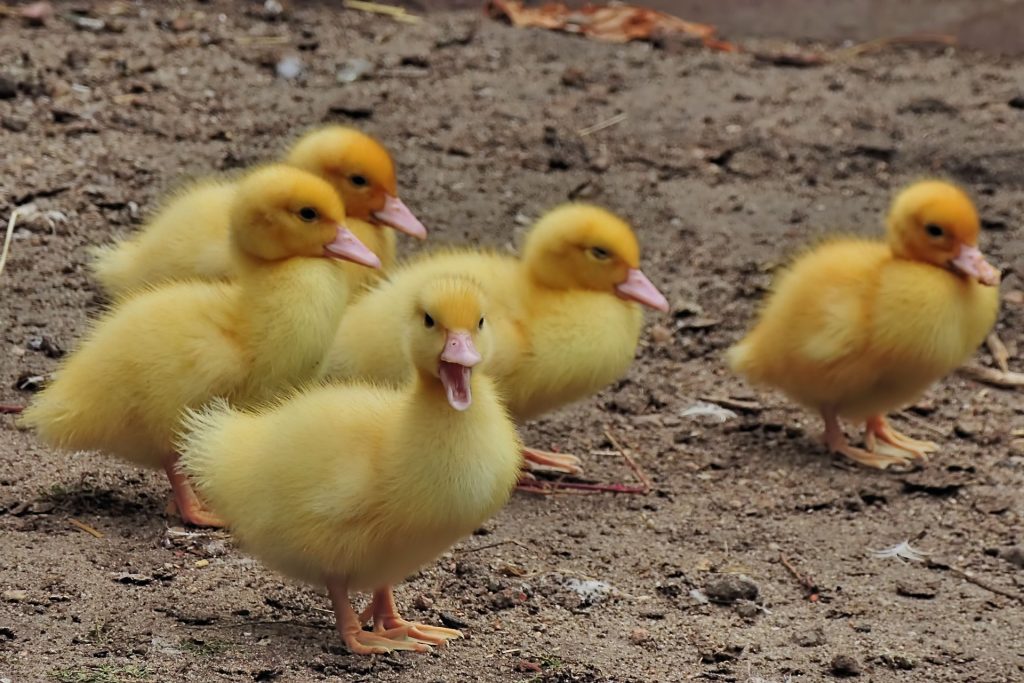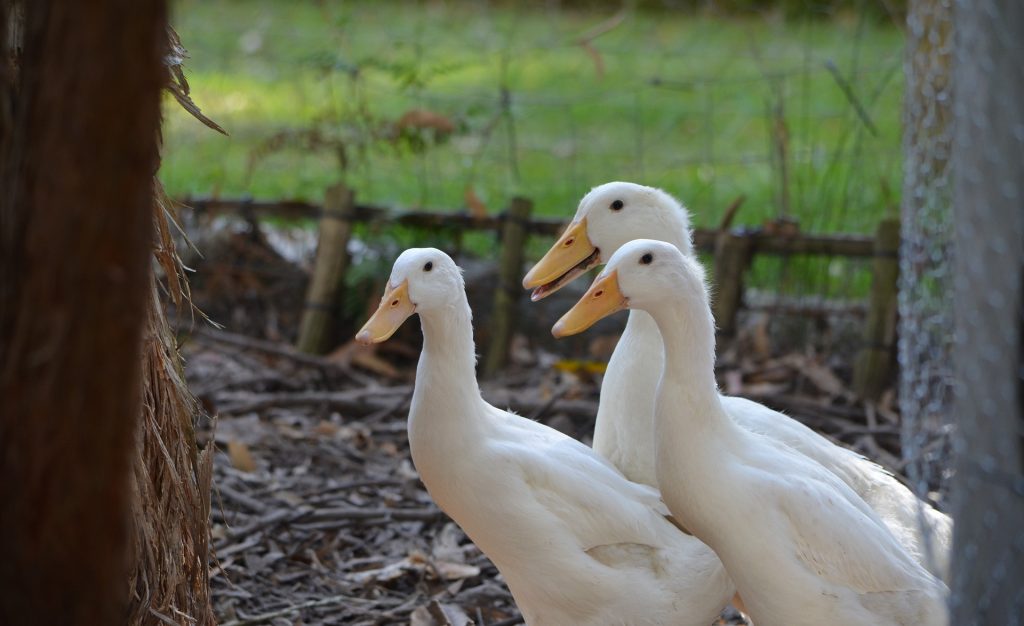Chickens and Ducks
Environment for chickens


Housing
- Housing to be warm, dry and well-ventilated.
- The house and everything inside should be cleaned frequently and disinfected to remove parasites.
- Food and water should be provided in the house.
Flooring - Covered with dry material (e.g. wood shavings or straw), to allow foraging and dust bathing (particularly
important when it’s wet outside). This must be topped-up or replaced when needed.
Space - Enough for chickens to exercise, stretch their wings and carry out normal behaviours.
- As a very approximate guide, 10% of your plot should be enough for a maximum of 10-12 birds. Although this depends on the size
and numbers of chickens and layout of facilities.
Perches - Should be around 3 to 5 centimetres wide with rounded edges and height should suit the size of the birds.
- Should provide enough space for all chickens to comfortably roost at the same time (from 15 centimetres
per chicken), and enough space between perches to let them get up and down without injury.
Nest boxes - Egg laying hens need quiet, enclosed nest boxes.
- Should be draught-free and lined with clean, dry, comfortable nesting material (e.g. straw or wood
shavings).
Entrance to the house/outdoor area - Should allow chickens to pass through easily without having to crouch.
- More than one entrance helps avoid bullying and encourages use of the outdoor area.
Outdoor area - Keep grass short. Long strands can become trapped in the chickens’ digestive system.
Size - Large enough to allow wet, muddy or barren areas to be sectioned off to recover and to minimise the risk
of disease, while still allowing enough space for chickens to roam on good pasture.
Enrichment outdoors - Provide overhead cover, such as small trees or purpose-built shelters, to give protection from the sun, bad
weather and wild animals, and encourage exploration. - Chickens should have access to dry soil where they can dust bathe and forage.
Food and water outdoors - Feed or water provided outside should be sheltered to keep it clean and dry. Avoid attracting rodents and
wild birds.
Fencing - Fences should be well maintained and provide protection against wild animals
- Ensure that the birds cannot escape or become trapped/injured.
Chickens diet
Water
- Chickens need constant access to clean and fresh water in the chicken house.
- Drinkers should be cleaned regularly.
- Chickens must be able to access water in icy weather (ice should not be removed using chemicals).
- Drinkers should prevent young chicks climbing in and drowning.
- If drinkers are changed, the chickens should still be provided with some of the type that they are familiar
with.
Food - Feed, suitable for their age and breed, should be provided in the chicken house to give them a balanced
diet. - Food dispensers should be cleaned regularly.
- Chickens need insoluble grit to help digestion (e.g. hard flint grit). Oyster shell is a soluble grit which
can provide extra calcium in the diet.
How many chickens to keep? - We recommend that people keep at least three hens (female chickens) which get on well together.
- Cockerels (male chickens) are not to be kept.
Introducing new chickens to the flock - Mixing of chickens that are unfamiliar with each other should be done carefully.
- Mixing birds with very different body sizes should be avoided, as this can result in bullying.
Health and welfare of chickens
Always contact a vet if you are concerned about the health and welfare of your chickens and for health check-ups.
Healthy birds are ‘bright-eyed’, alert and interested. Signs of poor health include:
- Hunched posture.
- Erect feathers.
- Head tucked under the wing.
- Reluctance to move.
- Hiding in corners.
Feather pecking
Feather pecking is where hens peck and pull at the feathers of other hens, sometimes leading to more serious
injuries and even cannibalism. It can affect hens in any system, including commercial farming systems and hens
kept as pets. Outbreaks can suddenly occur.
For more information please download the Laying hen feather cover advice guide (PDF: 572KB)
Parasites - Chickens need regular worming, particularly if kept with the same outdoor area for more than one month.
- Chickens should also be checked regularly for lice and red mites:
- Lice are 2 to 3 millimetres in size and can be found all over the body with eggs around the shafts of the
feathers. - Red mites are smaller and can be found under the wings, or in crevices within the house.
For more information please see https://poultrykeeper.com/ - or the RSPCA site for more advice
https://www.rspca.org.uk/adviceandwelfare/farm/farmanimals/chickens
Caring for ducks


Diet and Water
- Ducks need plentiful access to clean and fresh water at all times.
- Drinkers should be clean and cleaned regularly.
- Ducks must be able to access water in icy weather (ice should not be removed using
chemicals). - Water facilities should prevent young birds from drowning in them, i.e. they should be
designed so that the young birds can get out of the water easily. - If drinkers are changed, the birds should still be provided with some of the type that they are
familiar with until they have got used to the new ones.
Food - Feed, suitable for the species and the bird’s age and breed should be provided to give them a
balanced diet. - Food dispensers should be clean and cleaned out regularly.
- Ducks spend much of their time feeding in and around water.
Company
How many ducks or geese to keep? - We recommend that people keep at least three birds which get on well together.
Introducing new ducks to the flock - Mixing of birds that are unfamiliar with each other should be done carefully.
- Mixing birds with very different body sizes should be avoided, as this can result in bullying.
Health and welfare
Always contact a vet as soon as possible if you are concerned about the health and welfare of your
ducks for health check-ups.
Healthy birds are ‘bright-eyed’, alert and interested. Signs of poor health can include: - Hunched posture.
- Erect feathers.
- Head tucked under the wing.
- Reluctance to move.
- Hiding in corners or dark areas.
Indoor Areas for Ducks
Although ducks like water, they will seek protection and shelter from adverse weather, such as
driving rain, direct sunshine and strong winds. Suitable accommodation and shelters on the outdoor
area should therefore be provided.
Housing
- Should be warm, dry and well-ventilated.
- The house and everything inside should be cleaned frequently and disinfected to remove
parasites. - Food and water should be provided in the house.
Flooring - Should be covered with dry material (e.g. wood shavings, straw), to allow a comfortable
resting area. This must be topped-up or replaced when needed.
Space - There should be enough space inside the house for birds to move around easily, exercise,
stretch their wings and carry out normal behaviours. - We recommend providing at least one square metre of floor space for every two/three ducks.
Nest boxes - Female ducks may seek an isolated position to lay eggs, and prefer somewhere safe and
secluded, such as an individual nest box. - Nest boxes should be draught-free and lined with clean, dry, comfortable nesting material
(e.g. straw or wood shavings).
Entrance to the house/outdoor area for the birds - Should allow birds to pass through easily without having to crouch.
- More than one entrance helps avoid bullying and encourages use of the outdoor area.
Outdoor environment for ducks
It is important that the outdoor area is well managed, especially around any water facilities where the ground is likely to become wet and muddy.
Size
- The outdoor area should be large enough to allow wet, muddy or barren areas to be
sectioned off to recover and to minimise the risk of disease, while still allowing enough
space for birds to roam on good pasture. - Geese are grazers and need a particularly good-sized grassy area.
Enrichment
- Provide overhead cover (e.g. small trees, purpose-built shelters) in several areas to protect
from the sun, bad weather and wild animals.
Food and Water
- Feed or water provided outside should be sheltered to keep it clean and dry and to avoid
attracting rodents and wild birds.
Fencing - Well maintained and provide protection against wild animals.
- Ensure that the birds cannot escape or become trapped/injured.
Open Water Facilities
- Ducks should be provided with access to hygienically managed open water sources that
enable them to carry out their water-related behaviours. - The open water facility should be cleaned at least once every day before refilling with clean
water. - They should also have a separate supply of fresh drinking water, as open water sources can
become dirty very quickly. - Prevent the surrounding ground from becoming wet and muddy. This can be reduced by
regularly moving the water facilities to allow the area to recover, or by placing the water
facilities over a well-drained area, such as a bed of shingle. - Ducklings
- Shallow water troughs should be provided for the first few weeks of life.
- Young birds should not have access to deep water for swimming in until they have
developed adequate waterproofing on their feathers. - Ducks should be able to get into the water.
The behaviour of ducks
Farmed ducks have maintained many of the biological characteristics of their wild ancestors,
including: - Ducks are waterfowl and, under natural conditions, spend a large amount of time in an
The behaviour of ducks
Farmed ducks have maintained many of the biological characteristics of their wild ancestors,
including:
- Ducks are waterfowl and, under natural conditions, spend a large amount of time in and
around water. - They spend a lot of time performing complex preening behaviours to clean their feathers and
to re-distribute oil onto them from a gland above their tail. This keeps them waterproof and
helps to control their body temperature
Further information
For more information please see https://poultrykeeper.com/
All information in this document was obtained from the RSPCA website please consider supporting the RSPCA
https://www.rspca.org.uk/adviceandwelfare
Watertight: the case for providing farmed ducks with full body access to water. March 2015 (PDF 1.12MB)
The welfare of farmed ducks information sheet July 2012 (PDF 808KB)